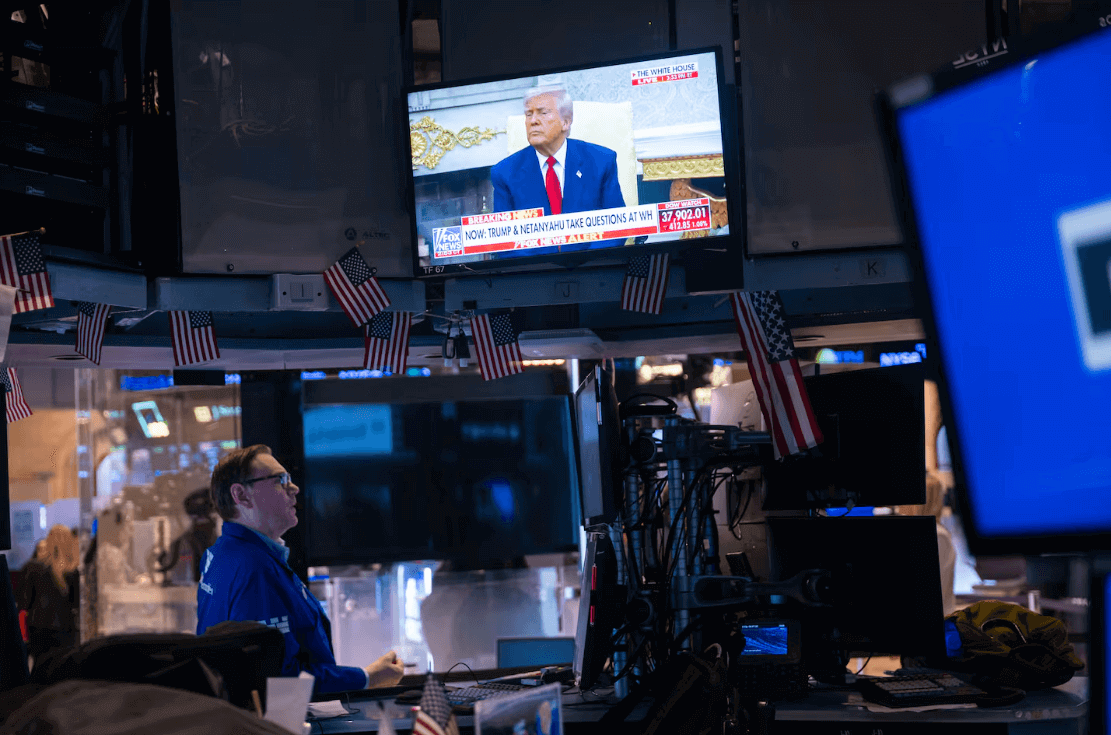特朗普试图让美国人关注他造成的市场崩溃

【中美创新时报2025 年 4 月 8 日编译讯】(记者温友平编译)所有总统都会犯错。有些总统曾向公众撒谎。大多数总统都试图用一种让坏消息看起来不那么糟糕的方式来掩盖它。但请不要误会:没有哪位美国总统像唐纳德·J·特朗普那样欺骗公众。《波士顿环球报》记者詹姆斯·平德尔对此作了下述报道。
“煤气灯效应”一词在 #MeToo 运动中变得流行起来。它描述了一种心理操纵——让某人质疑自己对现实的看法。这就是特朗普的做法如此危险的原因:这不仅仅是一种宣传,而是对共识现实的全面攻击。
是的,总统一直在影响公众舆论。他们为争取支持而竞选,召集选民,推销计划,并策划有利于自己的事件。但没有什么能比得上特朗普及其政府在关税及其经济后果方面所做的——并且仍在做的。(即使是 1 月 6 日对国会大厦的袭击也不同,因为并非所有美国人都能实时看到每个角度或回答每个问题。)
周一上午,特朗普经济顾问彼得·纳瓦罗 (Peter Navarro) 出现在 CNBC 上。当主持人讲述投资者的担忧以及主要分析师对潜在经济衰退的警告时,纳瓦罗笑了。尽管股市经历了 1987 年以来最糟糕的时期之一,但纳瓦罗坚称这实际上是“一个美好的局面”。
在屏幕的一角,CNBC 显示股市开盘将下跌 900 点。如果这一趋势持续下去,这将是自 1987 年黑色星期一崩盘以来最严重的三天股市暴跌。
但纳瓦罗只是在向他的老板传话。周日晚上,当一名记者在空军一号上问特朗普, 市场痛苦是否会达到一个无法接受的临界点时,总统厉声说:“我觉得你的问题太愚蠢了。”
自关税生效以来,美国政府以及许多保守派媒体盟友陷入了一种集体认知失调。他们暗示,即使人们在赔钱(他们把这当作一个很大的“如果”),这也没什么大不了的。他们想让你相信这无关紧要——或者根本就没有发生过。
但这确实发生了。对许多美国人来说,这意义重大。
周日,据报道身价高达 5 亿美元的财政部长斯科特·贝森特 (Scott Bessent)参加了 NBC 的“与媒体见面”节目并告诉美国人,他们的反应过度了。
“我认为这是错误的叙述,”他说。“那些想立即退休的美国人,那些多年来一直在储蓄账户中存钱的美国人,我认为他们不会关注每日的波动。”
但问题是:他们确实在看。尤其是当这些波动成为历史性崩盘时。假装不是这样并不代表事实。
当然,总统的操纵并非新鲜事。詹姆斯·布坎南曾试图说服美国人,他们日益加深的分歧并不是真正的危机——当时美国正濒临内战。林登·约翰逊夸大了北部湾事件,以加大美国在越南的介入。理查德·尼克松淡化了水门事件。乔治·W·布什则根据有关大规模杀伤性武器的虚假情报带领美国进入伊拉克。
但在上述每一起事件中,许多美国人都无法了解全部真相。他们不在战情室,也没有阅读机密简报。
此刻不同了。数字就在我们眼前。它们不是抽象的。它们在我们的手机、笔记本电脑和电视上随时可见。试图说服人们他们所看到的东西——红屏、市场暴跌、401(k) 余额暴跌——是别的东西,这没什么用。
然而,这正是特朗普政府继续尝试的。他们不只是在兜售谎言;他们告诉美国人不要理会他们亲眼看到的东西。
唯一与之相近的现代类似事件是特朗普最初对新冠肺炎的处理,当时尽管医院人满为患、死亡人数不断上升,他仍坚称病毒会“消失”。
他未能连任,部分原因就是那次灾难性的误判。
不过,特朗普会告诉你,他根本没有输过。
题图:周一,交易员在纽约证券交易所工作时,特朗普总统出现在电视屏幕上。斯宾塞·普拉特/盖蒂
附原英文报道:
Trump is attempting to gaslight Americans on the market crash he created
By James Pindell Globe Staff,Updated April 8, 2025, 5:58 a.m.
President Trump is seen on a television screen as traders work on the floor of the New York Stock Exchange on Monday. Spencer Platt/Getty
All presidents make mistakes. Some have lied about them to the public. Most try to spin bad news in a way that makes it seem less bad.
But make no mistake: No American president has ever gaslit the public quite like Donald J. Trump.
The term gaslighting gained prominence during the #MeToo movement. It describes a kind of psychological manipulation — getting someone to question their own perception of reality. That’s what makes Trump’s approach so dangerous: it’s not just spin, it’s a full-on assault on consensus reality.
Yes, presidents shape public opinion all the time. They campaign for support, rally voters, sell initiatives, and frame events to their advantage. But nothing compares to what Trump and his administration have tried to do — and are still doing — with tariffs and their economic consequences. (Even the January 6th attack on the Capitol was different because not all Americans could see every angle or answer every question in real time.)
On Monday morning, Trump economic adviser Peter Navarro appeared on CNBC. As the anchor ran down investor fears and warnings from leading analysts about a potential recession, Navarro smiled. Despite one of the worst stretches for the stock market since 1987, Navarro insisted it was actually “a beautiful situation.”
Tracking the major moves President Trump makes in the first 100 days of his second term
In the corner of the screen, CNBC showed the markets poised to open down 900 points. If the trend held, it would mark the worst three-day market tumble since the Black Monday crash of ‘87.
But Navarro was simply channeling his boss. When a reporter asked Trump Sunday night on Air Force One if there was a point at which market pain would become unacceptable, the president snapped: “I think your question is so stupid.”
Since the tariffs took effect, the administration — along with many conservative media allies — has engaged in a kind of collective cognitive dissonance. They’ve suggested, even if implicitly, that even if people are losing money (and they leave it as a big “if”), it’s not really a big deal. They want you to believe it doesn’t matter — or that it’s not even happening.
But it is happening. And for many Americans, it matters a great deal.
On Sunday, Treasury Secretary Scott Bessent — reportedly worth as much as $500 million — went on NBC’s Meet the Press and told Americans they were just overreacting.
“I think that’s a false narrative,” he said. “Americans who want to retire right now, the Americans who put away for years in their savings accounts, I think they don’t look at the day-to-day fluctuations.”
But here’s the thing: They do look. Especially when those fluctuations become historic crashes. Pretending otherwise doesn’t make it true.
Of course, presidential gaslighting isn’t new. James Buchanan tried to persuade Americans that their deepening divisions weren’t really a crisis — as the country edged toward Civil War. Lyndon B. Johnson exaggerated the Gulf of Tonkin incident to escalate US involvement in Vietnam. Richard Nixon downplayed Watergate. George W. Bush led the country into Iraq based on false intelligence about weapons of mass destruction.
But in each of those cases, many Americans didn’t have access to the full truth. They weren’t in the situation room. They weren’t reading the classified briefings.
This moment is different. The numbers are right in front of us. They’re not abstract. They’re instantly available on our phones, our laptops, our televisions. There’s little utility in trying to convince someone that what they’re seeing — a red screen, a tumbling market, their 401(k) balance tanking — is somehow something else.
Yet that’s exactly what the Trump administration continues to attempt. They’re not just spinning; they’re telling Americans to ignore what they can see with their own eyes.
The only modern parallel that comes close is Trump’s initial handling of COVID-19, when he insisted it would “just disappear” even as hospitals filled and the death toll mounted.
He lost reelection in part because of that catastrophic misjudgment.
Then again, Trump would tell you he never lost at all.

